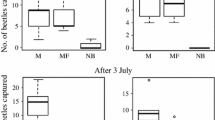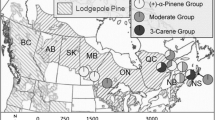Abstract
Ponderosa pine logs infested withIps paraconfusus males inhibited the attraction ofDendroctonus brevicomis in the field to either attractive logs cut from a ponderosa pine tree under attack byD. brevicomis or to their synthetic pheromones,exo-brevicomin, frontalin, and myrcene. Logs cut from trees under attack byD. brevicomis inhibited the response ofI. paraconfusus to logs infested with maleI. paraconfusus.Exo-brevicomin, frontalin, and myrcene did not inhibit their response but verbenone did. Verbenone was found in maleD. brevicomis dissected from attractive logs under attack during the same time the response ofI. paraconfusus was inhibited by these logs.Trans-verbenol andexo-brevicomin were found in femaleD. brevicomis while verbenone,trans-verbenol, and frontalin were found in maleD. brevicomis in relatively large amounts near the beginning of the aggregation phase of host colonization. All of these compounds had decreased at a similar rate 5 days later. This gradual decrease inexo-brevicomin and frontalin probably caused the observed reduction in attraction. The ecological significance of these compounds in relation to termination of the aggregation phase ofD. brevicomis and reduction of interspecific competition is discussed.
Similar content being viewed by others
References
Bedard, W.D., andBrowne, L.E. 1969. A delivery-trapping system for evaluating insect chemical attractants in nature.J. Econ. Entomol 62:1202–1203.
Bedard, W.D., Tilden, P.E., Wood, D.L., Silverstein, R.M., Brownlee, R.G., andRodin, J.O. 1969. Western pine beetle: Field response to the sex pheromone and a synergistic host terpene, myrcene.Science 164:1284–1285.
Bedard, W.D., Silverstein, R.M., andWood, D.L. 1970. Bark beetle pheromones.Science 167:1638–1639.
Bedard, W.D.,Wood, D.L.,Tilden, P.E.,Lindahl, K.Q.,Silverstein, R.M., andRodin, J.O. 1980a. Field response of the western pine beetle and one of its predators to host and beetle produced compounds.J. Chem. Ecol, in press.
Bedard, W.D.,Tilden, P.E.,Wood, D.L.,Lindahl, K.Q., andRauch, P.A. 1980b. Effects of verbenone and trans-verbenol on the response ofDendroctonus brevicomis to natural and synthetic attractant in the field.J. Chem. Ecol., in press.
Berryman, A.A. 1966. Studies on the behavior and development ofEnoclerus lecontei (Wolcott), a predator of the western pine beetle.Can. Entomol. 98:519–526.
Birch, M.C., andWood, D.L. 1975. Mutual inhibition of the attractant pheromone response by two species ofIps (Coleoptera: Scolytidae).J. Chem. Ecol. 1:101–113.
Borden, J.H. 1967. Factors influencing the response ofIps confusus (Coleoptera: Scolytidae) to male attractant.Can. Entomol. 99:1164–1193.
Borden, J.H., Chong, L., McLean, J.A., Slessor, K.N., andMori, K. 1976.Gnathotrichus sulcatus: Synergistic response to enantiomers of the aggregation pheromone sulcatol.Science 192:894–896.
Browne, L.E. 1972. An emergence cage and refrigerated collector for wood-boring insects and their associates.J. Econ. Entomol. 65:1499–1501.
Browne, L.E. 1978. A trapping system for the western pine beetle using attractive pheromones.J. Chem. Ecol. 4:261–275.
Browne, L.E., Wood, D.L., Bedard, W.D., Silverstein, R.M., andWest, J.R. 1979. Quantitative estimates of the attractive pheromone components,exo-brevicomin, frontalin, and myrcene, of the western pine beetle in nature.J. Chem. Ecol. 5:397–414.
Hughes, P.R., 1973.Dendroctonus: Production of pheromones and related compounds in response to host monoterpenes.Z. Angew. Entomol. 73:294–312.
Hughes, P.R., andPitman, G.B. 1970. A method for observing and recording the flight behavior of tethered bark beetles in response to chemical messengers.Contrib. Boyce Thompson Inst. 24:329–336.
Kinzer, G.W., Fentiman, A.F., Jr., Page, T.F., Jr., Foltz, R.L., Vité, J.P., andPitman, G.B. 1969. Bark beetle attractants and field bioassay of a new compound isolated fromDendroctonus.Nature 22:475–476.
Lanier, G.N., andWood, D.L. 1975. Specificity of response to pheromones in the genusIps (Coleoptera: Scolytidae).J. Chem. Ecol 1:9–23.
Lanier, G.N., Birch, M.C., Schmitz, R.F., andFurniss, M.M. 1972. Pheromones ofIps pini (Coleoptera: Scolytidae): variation in response among three populations.Can. Entomol. 104:1917–1923.
Libbey, L.M., Morgan, M.E., Putnam, T.B., andRudinsky, J.A. 1974. Pheromones released during inter- and intra-sex response of the scolytid beetleDendroctonus brevicomis.J. Insect Physiol. 20:1667–1671.
McCall, R.B. 1970. Fundamental Statistics for Psychology. Harcourt, Brace and World, Inc., New York. 419 pp.
McNew, G.L. 1970. The Boyce Thompson institute program in forest entomology that led to the discovery of pheromones in bark beetles.Contrib. Boyce Thompson Inst. 24:251–262.
Miller, J.M., andKeen, F.P. 1960. Biology and Control of the Western Pine Beetle. U.S.D.A. Misc. Publ. No. 800, 381 pp.
Pitman, G.B., andVité, J.P. 1963. Studies on the pheromone ofIps confusus (LeC.). I. Secondary sexual dimorphism in the hindgut epithelium.Contrib. Boyce Thompson Inst. 22:221–226.
Pitman, G.B., andVité, J.P. 1970. Predator-prey response to western pine beetle attractants.J. Econ. Entomol. 64:402–404.
Pitman, G.B., Kliefoth, R.A., andVité, J.P. 1965. Studies on the pheromone ofIps confusus (LeConte). II. Further observations on the site of production.Contrib. Boyce Thompson Inst. 23:13–17.
Pitman, G.B., Renwick, J.A.A., andVité, J.P. 1966. Studies on the pheromone ofIps confusus (LeConte). IV. Isolation of the attractive substance by gas-liquid chromatography.Contrib. Boyce Thompson Inst. 23:243–250.
Pitman, G.B., Vité, J.P., Kinzer, G.W., andFentiman, A.F.Jr. 1969. Specificity of population-aggregating pheromones inDendroctonus.J. Insect Physiol 15:363–366.
Renwick, J.A.A. 1967. Identification of two oxygenated terpenes from the bark beetlesDendroctonus frontalis andDendroctonus brevicomis.Contrib. Boyce Thompson Inst. 23:355–360.
Renwick, J.A.A., andVité, J.P. 1968. Isolation of the population aggregating pheromone of the southern pine beetle.Contrib. Boyce Thompson Inst. 24:65–68.
Renwick, J.A.A., andVité, J.P. 1970. Systems of chemical communication inDendroctonus. Contrib.Boyce Thompson Inst. 24:283–292.
Renwick, J.A.A., Hughes, P.R., andKrull, I.S. 1976. Selective production ofcis and trans-verbenol from (−) and (+) alpha-pinene by a bark beetle.Science 191:199–201.
Silverstein, R.M., andRodin, J.O. 1965. Spectrometric identification of organic compounds on a milligram scale. The use of complementary information.Microchem. J. 9:301–308.
Silverstein, R.M., Rodin, J.O., andWood, D.L. 1966a. Sex attractants in frass produced by maleIps confusus in ponderosa pine.Science 154:509–510.
Silverstein, R.M., Rodin, J.O., Wood, D.L., andBrowne, L.E. 1966b. Identification of two new terpene alcohols from frass produced byIps confusus in ponderosa pine.Tetrahedron 22:1929–1936.
Silverstein, R.M., Brownlee, R.G., Bellas, T.E., Wood, D.L., andBrowne, L.E. 1968. Brevicomin: principal sex attractant in the frass of the female western pine beetle.Science 159:889–891.
Spiegel, M. R. 1961. Theory and Problems of Statistics. Schaum's Outline Series, McGraw-Hill, New York, 359 pp.
Stephen, F.M., andDahlsten, D.L. 1976. The temporal and spacial arrival pattern ofDendroctonus brevicomis in ponderosa pine.Can. Entomol. 108:271–282.
Struble, G.R., andHall, R.C. 1955. The California five-spined engraver, its biology and control. U.S.D.A. circular No. 964, 21 pp.
Vité, J.P., andGara, R.I. 1962. Volatile attractants from ponderosa pine attacked by bark beetles (Coleoptera: Scolytidae).Contrib. Boyce Thompson Inst. 21:251–273.
Vité, J.P., andPitman, G.B. 1968. Bark beetle aggregation: Effects of feeding on the release of pheromones inDendroctonus andIps.Nature 218:169–170.
Vité, J.P., andPitman, G.B. 1969a. Aggregation behavior ofDendroctonus brevicomis in response to synthetic pheromones.J. Insect Physiol. 15:1617–1622.
Vité, J.P., andPitman, G.B. 1969b. Insect and host odors in the aggregation of the western pine beetle.Can. Entomol. 101:113–117.
Vité, J.P., andRenwick, J.A.A. 1970. Differential diagnosis and isolation of population attractants.Contrib. Boyce Thompson Inst. 24:323–328.
Wood, D.L. 1970. Pheromones of bark beetles, pp. 301–316,in D.L. Wood, R.M. Silverstein, and M. Nakajima (eds.), Control of Insect Behavior by Natural Products. Academic Press, New York.
Wood, D.L. 1972. Selection and colonization of ponderosa pine by bark beetles, in: Insect/Plant Relationships. H.F. van Emden, (ed.).Sym. Royal Entomol. Soc. London, No. 6.
Wood, D.L., andBushing, R.W. 1963. The olfactory response ofIps confusus (LeConte) (Coleoptera: Scolytidae) to the secondary attraction in the laboratory.Can. Entomol. 95:1066–1078.
Wood, D.L., andBedard, W.D. 1977. The role of pheromones in the population dynamics of the western pine beetle.Proc. XV Intern. Congr. Entomol. 643–652.
Wood, D.L., Browne, L.E., Silverstein, R.M., andRodin, J.O. 1966. Sex pheromones of bark beetles—I. mass production, bioassay, source, and isolation of the sex pheromone ofIps confusus (LeC.).J. Insect Physiol. 12:523–536.
Wood, D.L., Stark, R.W., Silverstein, R.M., andRodin, J.O. 1967. Unique synergistic effects produced by the principal sex attractant compounds ofIps confusus (LeConte) (Coleoptera: Scolytidae).Nature 215:206.
Wood, D.L., Browne, L.E., Bedard, W.D., Tilden, P.E., Silverstein, R.M., andRodin, J.O. 1968. Response ofIps confusus to synthetic sex pheromones in nature.Science 159:1373–1374.
Wood, D.L., Browne, L.E., Ewing, B., Lindahl, K., Bedard, W.D., Tilden, P.E., Mori, K., Pitman, G.B., andHughes, P.R. 1976. Western pine beetle: specificity among enantiomers of male and female components of an attractant pheromone.Science 192:896–898.
Young, J.C., Silverstein, R.M., andBirch, M.C. 1973. Aggregation pheromone of the beetleIps confusus: Isolation and identification.J. Insect Physiol. 19:2273–2277.
Author information
Authors and Affiliations
Additional information
Coleoptera: Scolytidae. This paper is based in part upon a dissertation submitted by J.A.B. to the University of California, Berkeley, in partial fulfillment of the requirements for the PhD in entomology. These studies were supported in part by the Rockefeller Foundation; U.S. Forest Service; Regional research Project W-110, S.E.A./ U.S.D.A.; and the National Science Foundation and Environmental Protection Agency through a grant (NSF GB-34719/BMS 75-04223) to the University of California.
Rights and permissions
About this article
Cite this article
Byers, J.A., Wood, D.L. Interspecific inhibition of the response of the bark beetles,Dendroctonus brevicomis andIps paraconfusus, to their pheromones in the field. J Chem Ecol 6, 149–164 (1980). https://doi.org/10.1007/BF00987534
Received:
Revised:
Issue Date:
DOI: https://doi.org/10.1007/BF00987534




